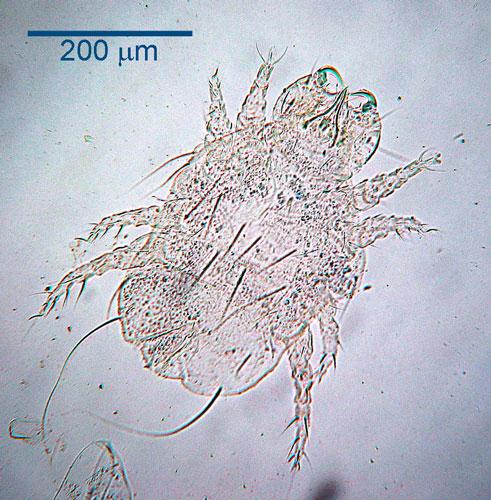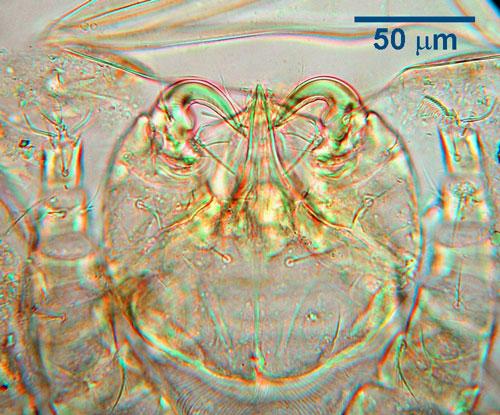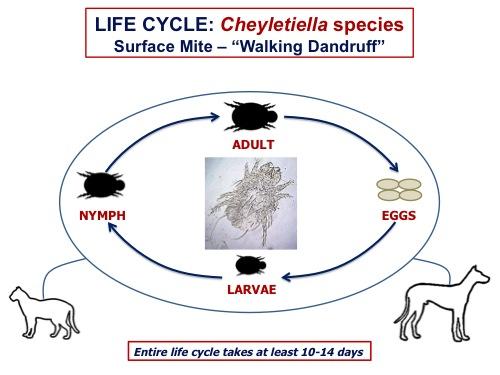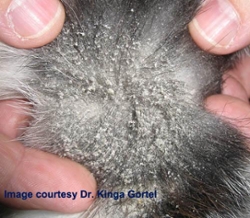
Cheyletiella species
Dogs and cats each have their own species of the mite Cheyletiella, which appear to be host-specific — C. yasguri in dogs and C. blakei in cats.
Summary

Dogs and cats each have their own species of the mite fur Cheyletiella, which appear to be host-specific — C. yasguri in dogs and C. blakei in cats.
Cheyletiella occurs on these hosts around the world. The entire life cycle of the mites occurs on the host. In general, dogs are more likely to show clinical signs (primarily pruritis, scaliness and eczema-like skin lesions around the face), than are cats. These surface mites can be easily seen moving around in the haircoat - "walking dandruff". Cheyletiella transmits readily to people, who can show clinical signs in the absence of signs in the pet, or before such signs develop.
Taxonomy
Phylum: Arthropoda
Subphylum: Chelicerata
Class: Arachnida
Subclass: Acari
Order: Prostigmata
Cheyletiella species are in the same Order as Demodex and Neotrombicula, which is different from that containing Sarcoptes, Notoedres, Psoroptes, Chorioptes and Otodectes, and from that containing Dermanyssus and Ornithonyssus.
Morphology
Host range and geographic distribution
Life cycle

Epidemiology
Infestations with Cheyletiella species mites are very contagious, particularly among young animals or those that are immunosuppressed or in other ways stressed. Although the larvae and nymphs are not thought to be able to survive off the host for more than a few days, adults may survive for longer (maybe a few weeks), and it is possible that bedding and other fomites may act as sources of infestation. In some instances, eggs of Cheyletiella in the environment might be a source of infestation for pets.
Pathology and clinical signs

Some infested dogs and cats have few mites, but very severe clinical signs, particularly pruritus. These animals may have developed a hypersensitivity reaction and may develop exfoliative erythroderma, or lesions that mimic scabies. Cats sometimes develop miliary dermatitis or develop dorsal hypotrichosis without skin lesions.
Diagnosis
To recover mites, the animal can be stood on a dark plastic sheet, brushed or combed against the lie of the coat, and the material collected then examined, either directly after immersing in mineral oil (to prevent the live mites from escaping) or following a potassium hydroxide digest as used for routine skin scrapings. Rather than brushing, skin debris can be collected on clear adhesive tape and examined as above, or a vacuum with an in-line filter can be used. Vacuuming the animal using a filter and examining the debris collected is very effective for Cheyletiella, in part because most or all of the external surface of the animal can be examined. Standard skin scrapings are not very effective for Cheyletiella, primarily because they are surface mites.
The presence of typical Cheyletiella skin lesions on the owner, or on other people in contact with an affected animal, sometimes in the absence of clinical signs in the animals, may be the first sign that the dog or cat has the mites. Failure to recover mites from a pet with compatible clinical signs and history should not rule out the diagnosis of cheyletiellosis.
Treatment and control
With Cheyletiella it is very important to effectively treat all in-contact animals (including dogs, cats, rabbits etc) even if they are asymptomatic and to remove or thoroughly clean any potential fomites, for example bedding. Effective treatment of Cheyletiella can be difficult because of the often large numbers of mites present and the possibility of re-infection from the environment. Also, resolution of the clinical signs does not always mean that the animal is mite-free, and so in some cases it might be advisable to continue treatment until several periodic examination of the haircoat and skin surface are negative for mites.
Public health significance
Among the primary signs in people are an intense pruritus and grouped erythematous macules. These develop a central papule which becomes vesicular, then pustular, then bursts to produce a yellow crust. The lesions are most often on the arms and trunk.
References
Curtis CF (2004) Current trends in the treatment of Sarcoptes, Cheyletiella and Otodectes mite infestations in dogs and cats. Veterinary Dermatology, 15: 108-114.

